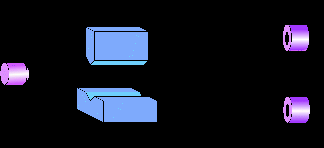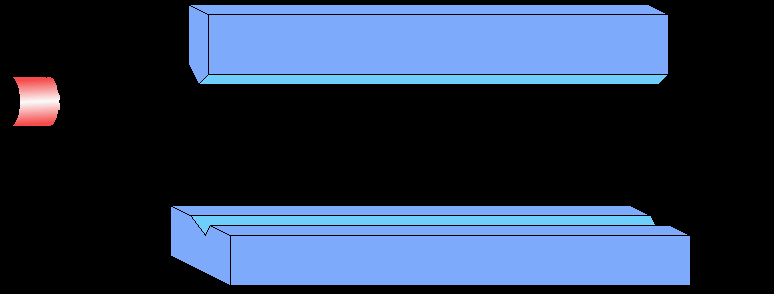"Protective" measurements in quantum mechanics
Quantum mechanics is the most bizarre, and yet highly successful of the
theories we know today. When applied to the physical world it comes out
with flying colors. Yet the picture of reality which it leads to, is
mind-boggling, to say the least. Einstein found the whole thing pretty
hard to swallow and could not come to terms with it till the end of his
life. In our familiar "classical" world, particles have well defined
postions and momenta which are unique. Quantum mechanics on the other
hand, allows for possibilities where the particle can be simultaneously
"here" and also "there", so to speak. The idea can be best illustrated
with the following example.
The Stern-Gerlach experiment
 This is a schematic representation of the classic Stern-Gerlach
experiment with spin-half particles. A particle emerges from the source
and travels towards the screen. The spin of the particle, at time t=0,
is in a superposition state of pointing "up" (|+>) and pointing "down"
(|->). It can be represented by
This is a schematic representation of the classic Stern-Gerlach
experiment with spin-half particles. A particle emerges from the source
and travels towards the screen. The spin of the particle, at time t=0,
is in a superposition state of pointing "up" (|+>) and pointing "down"
(|->). It can be represented by
|t=0> = a|+> + b|->
As it passes through the magnets, the "up"
component of the spin pulls the particle up, and the "down" component
pulls it down. As a result, the particle becomes "fuzzy" and splits into
a superposition of two wave-packets travelling in different directions.
This is a bizarre state of the particle - it is simultaneously in two
positions!
When this superpostion of wave-packets, on reaching the
other end, interacts with the detectors, the quantum coherence is
destroyed, and the particle is detected at one of the two positions. It
will be detected up with a probability |a|2
, and down with a probablity |b|2
. We are back to the familiar classical world.
This last stage where the superposition of the two wave-packets is
destroyed, and one ends up with a particle either "here" or "there", is
loosely referred to as the wave function
collapse.
For those who are not shocked by the above experiment,
look at the case of the
Schrodinger's Cat!
What is unknown, cannot be known!
As one might have guessed, after a measurement like the one made in
the example described above, one doesn't acquire any information
about the original state |t=0>. In a single measurement one either gets
an "up" spin or a "down" spin - one doesn't know what original state
led to the result obtained. And after one measurement, the state is
irretrievably destroyed. So, any subsequent measurements too do not
tell us anything about the original state. In effect, if the state is
initially unknown, there is absolutely no way of knowing it! This is the
generally accepted credo of quantum mechanics.
This scenario seems to indicate that the state, or the wavefunction, is
not real - only if we possess sufficient knowledge about a system, we
construct a wave-function for it. The fact that the only
wave-functions we can measure are the ones already known to us, leads
one to conclude that the wave-function is an entity which is formed out
of our knowledge of the system - it doesn't have an independent
existence. To put it in the philosophers jargon, the status of
wave-function is "epistemological" (based on
knowledge), and not "ontological" (real).
Can an unknown wave-function be "measured"?
Yakir Aharonov, Jeeva Anandan and Lev Vaidman
came up with a scheme which they called "protective measurement", which is claimed to yield
information about unknown wave-functions, although of a very special
class. Let us try to understand what these protective measurements
are.
Conventional measurement
Let us first see what happens in a conventional measurement, like the
one in the SG experiment described above. Assume a particle of mass m,
travelling along the x axis, a magnetic field along the z-axis, and
that the field is inhomgeneous along the y-axis. Let the particle be in a
wave-packet state centered around y=0, and can be respresented by the
wavefunction f(0). Let the state of the spin be written as a|+>+b|->.
The full wave-function of the particle at time t=0, when the particle
just enters the region of the magnetic field, is thus written as
|t=0> = ( a|+> + b|-> ) f(0)
Let the magnetic field be of the form yB - then the Hamiltonian of the
system is given by
H = p2/2m + yB Sz
where p the momentum of the particle along the y-axis and m is its
mass. Then one can easily write the wave-function at time t=T as:
|t=T> = eiHT ( a|+> + b|-> ) f(0).
One can assume that the particle is in the region of the magnetic
field for a very short time, and the magnetic field is so strong that
one can neglect the first term in the Hamiltonian. Then,
|t=T> = eiyB SzT ( a|+> + b|-> ) f(0).
We know that |+> and |-> are the eigenstates of Sz so that,
Sz|+> = |+> and Sz|-> = -|->. Using this, one
can write the above equation as:
|t=T> = a|+>eiyBTf(0) + b|->e-iyBTf(0).
Here eiyBTf(0) and e-iyBTf(0) represent two
wave-packets evolving in two different dierections. Also, these
wave-packets are correlated with the spin states |+> and |->
respectively. Such a state is called an entangled
state. In this state, if one detects the position of the
particle, one will get any one of the two wave-packets, and the spin
state will "collapse" to the state correlated with that wave-packet.
Thus we see that in a conventional measurement, the descruction of the
initial state is inevitable because of the entanglement.
Protective measurement
Protective measurements are similar to conventional measurements
except that they are weak and
adiabatic (slow). But this makes the crucial difference as we
will see now. Because the interaction is weak and acts for a long
time, we cannot neglect the "free" Hamiltonian of the system and the
apparatus. So the total Hamiltonian of the system-apparatus can be
written as:
H = p2/2m + g(t)p Qs + Hs
Here we assume that the interaction depends on p instead of the
position of the particle. Hs is the Hamiltonian of the
spin, which we need not specify now, and Qs is the
observable of the spin which is going to be measured. Let us assume
that the interaction acts for a time T which is very large, and the
interaction strength is constant and equal to 1/T for most of the
time. The initial state |t=0> = |n>|f(r)> where f(r) is a wavepacket
centered at position r, and |n> is a non-degenerate eigenstate of
Hs.
We can divide the time T into N tiny intervals so that DelT=T/N. So
the full wavefunction at the time T can be written as
|t=T> = [exp{-iDelT(p2/2m + Hs +
pQs /T)} ]N |t=0>
Now the eigenstates of the spin-apparatus combine can be written as
|p>|n'>, where |n'> are the modified spin eigenstates, and depend on
the value of the momentum of the particle, p. These are the eigenstates
of the instantaneous Hamiltonian. Using this the time evolution of the
state can be expressed as
|t=T> = Sump,m [exp{iE(p,m)NDelT)}
|p>|m'><m'|n> <p|f(r)>
where the energy eigenvalue E(p,m) is given by
E(p,m) = p2/2m + p<m'|Qs|m'>/T +
<m'|Hs|m'>
Now because the interaction is weak and slow, the states |m'> are
nearly the same as |m>, and can be written as
|m'> = |m> + O(1/T) + ...
Similarly, the eigenvalues can be written in terms of |m> instead of
|m'>:
E(p,m) = p2/2m + p<m|Qs|m>/T +
<m|Hs|m> + O(1/T2)
Now one can see that the second term in the above expression, being in
the exponent in the time evolution of the state, with shift the
position of a wave-packet by an amount <m|Qs|m>:
|t=T> = exp{-ip2/2mT-inT}
|n>|f(r+<m|Qs|m>)>
But this is just the expectation value of the observable we started out
to measure! This in essence is the idea behind protective measurement.
The center of the wave-packet shifts by an amount equal to the
expectation value of the operator being measured. The spin state on the
other hand, does not change appreciably. So, in the limit T becoming
really large, one gets the shift of the wave-packet, but the spin state
remains the same, which means one has measured some observable of the
spin without disturbing its state. It appears that
we can know something about an unknown wavefunction, provided it is a
non-degenerate eigenstate of the Hamiltonian.
Are there any problems?
- In the last equation we only look at the effect of the interaction
term on the wave-packet - we haven't looked at the effect of
p2/2m. This term will make the wave-packet spread with time.
And if the time is very large, as is the case here, the wave-packet
will shift by a tiny amount, but may spread so much that we do not know
where its center is.
- Although the center of the wave-packet gets shifted, in order that
an experimenter know how much is the shift, he or she would like to
know where the center is located. A single measurement on the
wave-packet can give the center to be anywhere within the spread of
the wave-packet, and not necessarily at the true center.
A schematic representation of a protective measurement.
Here the postion wave-packet of the particle doesn't get entangled with the
spin, hence the wave-packet doesn't split into two. The position of
the wave-packet gets shifted by an amount equal to the expectation
value of the observable being measured, that is <Qs>. Notice
how the wave-packet
spreads a lot, and makes it difficult to measure the shift of the
particle position.

|
This problem will be unavoidable when one tries to practically
implement protective measurements. One might argue that the apparatus
has to be of a classical nature, but here during the adiabatic
interaction of the system and the apparatus the evolution of the
apparatus has to be unitary. This whole analysis hinges on that. So,
classical nature has to emerge later. It might emerge through
interaction with some kind of an environment, by the mechanism of
decoherence.
On the other hand one can treat the apparatus like a quantum system,
as in the Stern-Gerlach experiment, and "detect" the apparatus using
a classical apparatus. This will be a conventional measurement leading
to a collapse of the apparatus wae-packet. In this scenario, we suggest
two ways out of this problem.
Repeated measurement of a single state
A wave-packet, when detected, collapses to a random position
within the spread of the packet.

|
One way is to make a large number of measurements on the same
single quantum system. We can make use of the fact that in protective
measurements, the wave-function of the system remains unchanged. After
one measurement, if you detect the position of the wave-packet, you
will get a particular random value within the spread of the packet.
The system state remains the same, and so you can repeat the protective
measurement which will give you another value for the position of the
wave-packet. You can repeat this procedure as many time as you want.
You can see that a large number of measurements will be like having an
ensemble of the apparatus wave-packets.
Detecting these wave-packets will then yield a large number of values,
whose average will be the center of the wave-packet. This is a strange
kind of a scenario where one uses a single quantum system, but an
ensemble of apparatus!
Quantum Nondemolition Measurement of the Apparatus
There is another interesting way out of this problem. For this we make
use of certain special kind of measurements, called Quantum
Non-Demolition (QND) measurements. This scheme is based on repeated
weak quantum nondemolition measurements performed on the
apparatus. Recently Alter and
Yamamoto analyzed the problem of a series of repeated weak QND
measurement on a quantum system, to address the question of getting
information about the unknown wave function of a single quantum system
from such measurements. They concluded that it is possible to obtain
the mean value of an observable in an unknown state, but no information
can be obtained about the uncertainty of the observable. While the
conclusions of Alter and Yamamoto were negative as far as using
repeated weak QND measurements to determine the unknown wave function
of a single system, it appears tailor-made to solve the problem of
"reading the pointer position" in protective measurements. Thus we
apply their scheme not to the system part of the protective
measurement, but to the apparatus part instead. Then we can get
information about the center of the wave packet, which in the
protective measurement scheme carries information on the expectation
values of observables in the system state.
A wave-packet going through a series of QND measurements.

|
The sequence of QND measurements evolves like this. With each
measurement, the center of the wave-packet shifts slightly and also
becomes slightly narrow. So, for a large number of such measurements,
the center of the wave-packet executes a random walk around the
original center, with progressively decreasing step size (see picture).
In effect, the packet becomes narrower and narrower and comes closer to
the original center as the number of measurements increases. It finally
collapses on to the original center.
Thus one may proceed with a protective measurement by first
allowing an adiabatic interaction of the system with an apparatus
which
can be treated quantum mechanically. This would result in a shifted
wave packet of the pointer. One can then do a series of weak QND
measurements on this wave packet to get the position of the center.
This seems the most promising possibility for experimentally realizing
protective measurements.
Does it really work for single system?
In a realistic situation, the time of interaction can only be very
large, but not infinite. As a result, there is always a very tiny
entanglement left, which is of the order 1/T. This entanglement does
change the wavefunction to a tiny extent. In the unlucky situation the
detection of the apparatus wave-packet might lead to a collapse to
this infinitesimal, but non-zero, branch of the entangled
wave-function.
Thus, if you are just given one single system in an unknown energy
eigenstate, you cannot be hundred percent sure that you have measured
the right state.
For a detailed analysis of protective measurements,
see (
N.D. Haridass and T. Qureshi, quant-ph/9805012).
 Back to my Physics Page
Back to my Physics Page
 This is a schematic representation of the classic Stern-Gerlach
experiment with spin-half particles. A particle emerges from the source
and travels towards the screen. The spin of the particle, at time t=0,
is in a superposition state of pointing "up" (|+>) and pointing "down"
(|->). It can be represented by
This is a schematic representation of the classic Stern-Gerlach
experiment with spin-half particles. A particle emerges from the source
and travels towards the screen. The spin of the particle, at time t=0,
is in a superposition state of pointing "up" (|+>) and pointing "down"
(|->). It can be represented by 

